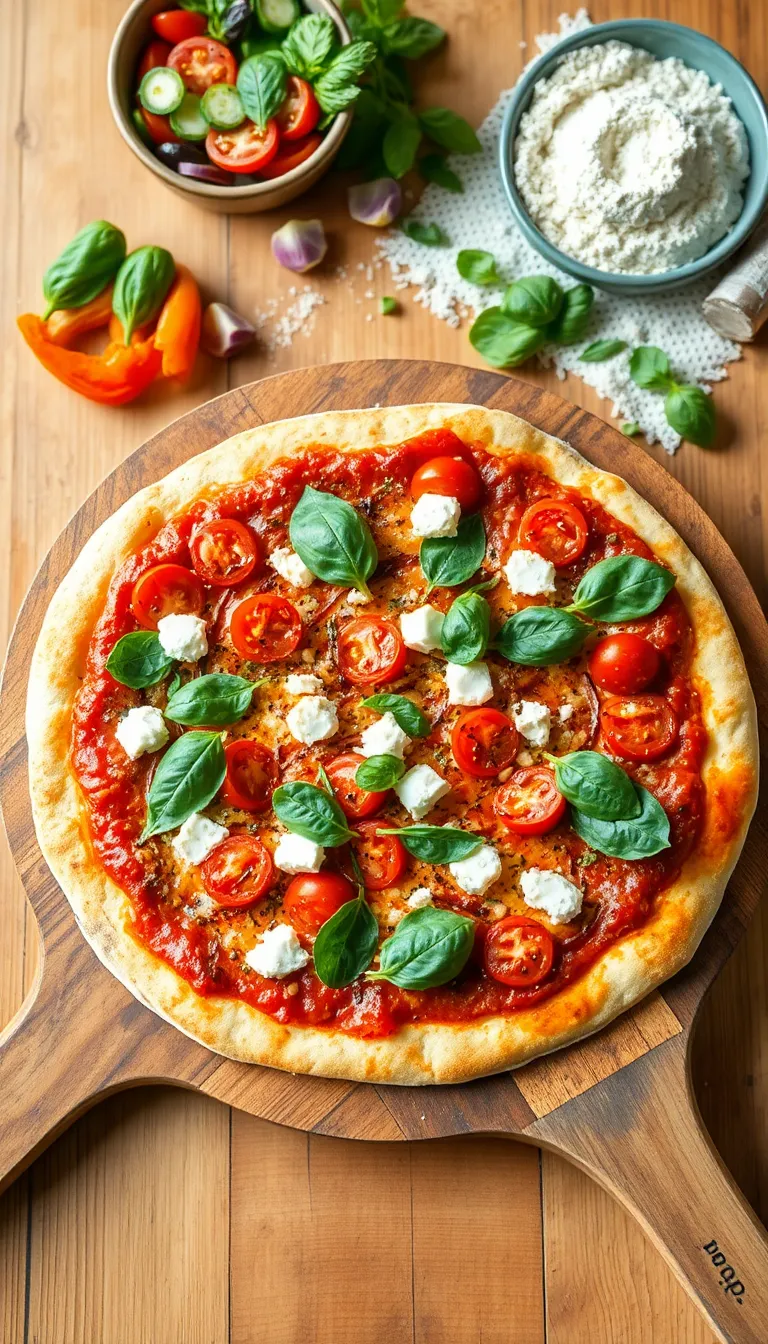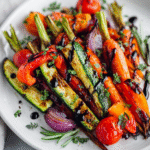Imagine the aroma of freshly baked dough wafting through your kitchen, topped with a vibrant medley of colorful vegetables and gooey, melted cheese. Whether you’re a beginner eager to try your hand at homemade pizza or a seasoned chef looking to perfect your pie, this Vegetarian Pizza Recipe promises a delightful culinary adventure. It’s a celebration of flavors, from the tangy burst of sun-dried tomatoes to the earthy richness of roasted red peppers.
This recipe stands out not just for its simplicity but for the way it brings together a symphony of textures and tastes. With every bite, savor the crisp crust, the creamy mozzarella, and the subtle hint of basil that ties it all together. Rest assured, both your taste buds and your confidence will soar as you create this delectable masterpiece in the comfort of your own kitchen.
About This vegetarian pizza Recipe

- Flavor-packed delight: This vegetarian pizza is bursting with vibrant flavors from fresh vegetables and savory herbs, creating a mouthwatering experience in every bite.
- Quick and easy: With simple ingredients and a streamlined preparation process, you can have a delicious homemade pizza ready in no time.
- Customizable toppings: Tailor this recipe to your liking by adding your favorite vegetables or experimenting with different cheeses for a personal touch.
- Healthier alternative: Using a variety of fresh, nutrient-rich veggies makes this pizza a wholesome choice without compromising on taste.
- Perfect for all occasions: Whether it’s a weeknight dinner or a weekend gathering, this vegetarian pizza is sure to impress and satisfy everyone.
Why You’ll Love This Recipe

- Quick and Easy: This vegetarian pizza recipe is perfect for busy weeknights, taking less than 30 minutes to prepare from start to finish.
- Customizable Toppings: Enjoy endless possibilities by choosing your favorite vegetables and cheeses, making each pizza uniquely yours.
- Rich Flavor Profile: With a blend of fresh herbs, tangy tomato sauce, and gooey mozzarella, every bite bursts with delicious flavors.
- Healthier Option: Packed with colorful veggies, this pizza is a nutritious choice that satisfies both your taste buds and your dietary needs.
- Family-Friendly: Kids and adults alike will love getting involved in the pizza-making process, making it a fun activity for everyone.
- Budget-Friendly: Using simple, everyday ingredients, this recipe offers a cost-effective way to enjoy a gourmet meal at home.
Ingredients
- 1 pizza dough (store-bought or homemade)
- 1/2 cup tomato sauce
- 1 cup shredded mozzarella cheese
- 1/4 cup grated Parmesan cheese
- 1 red bell pepper, sliced
- 1 small red onion, thinly sliced
- 1/2 cup sliced mushrooms
- 1/2 cup black olives, sliced
- 1/4 cup artichoke hearts, quartered
(available canned or jarred; rinse if packed in brine)
- 1/2 cup fresh spinach leaves
- 1/2 teaspoon dried oregano
- 1/2 teaspoon dried basil
- 1 tablespoon olive oil
- 1/4 teaspoon crushed red pepper flakes
(adjust to taste for a spicier pizza)
- Fresh basil leaves for garnish (optional)
- 1/4 cup crumbled feta cheese (optional)
Kitchen Tools You’ll Need
- Pizza Stone or Baking Sheet: Used to bake the pizza, ensuring a crispy crust. If you don’t have a pizza stone, a regular baking sheet will work as an alternative.
- Rolling Pin: Essential for rolling out the pizza dough to your desired thickness. If you don’t have a rolling pin, a clean bottle can serve as a substitute.
- Mixing Bowl: Needed for mixing and proofing the pizza dough.
- Knife: Used to chop vegetables and other toppings for the pizza.
- Cutting Board: Provides a stable surface for cutting and preparing ingredients.
- Measuring Cups and Spoons: Important for accurately measuring ingredients for the dough and toppings.
- Pizza Cutter or Sharp Knife: For slicing the cooked pizza into servings. If you don’t have a pizza cutter, a sharp kitchen knife will work.
Preparation Steps
- Preheat your oven to 475°F (245°C) and place a pizza stone or baking sheet inside to heat.
- Roll out the pizza dough on a floured surface until it’s approximately 12 inches in diameter and about 1/4 inch thick; the dough should be even and not too sticky.
- Transfer the rolled-out dough to a piece of parchment paper; this will make it easy to slide onto the hot baking surface.
- Spread a thin layer of tomato sauce over the dough, leaving a 1/2-inch border around the edges for the crust.
- Sprinkle an even layer of shredded mozzarella cheese over the sauce, ensuring coverage without overloading.
- Top with your choice of sliced vegetables, such as bell peppers, mushrooms, and olives; distribute evenly for consistent cooking.
- Carefully slide the parchment paper with the pizza onto the preheated pizza stone or baking sheet. Bake for 10-12 minutes or until the crust is golden brown and the cheese is bubbly.
- Remove the pizza from the oven and let it cool for a few minutes on a wire rack before cutting; this will help prevent the toppings from sliding off.
Serving Suggestions

- Fresh Arugula Salad: Pair your vegetarian pizza with a light arugula salad dressed in lemon vinaigrette. The peppery arugula and citrusy dressing enhance the flavors of the pizza without overpowering it.
- Herb-infused Olive Oil: Drizzle the pizza with a touch of herb-infused olive oil, such as rosemary or basil. This adds a fragrant aroma and an extra layer of flavor that complements the toppings.
- Chilled White Wine: Serve the pizza with a glass of chilled Sauvignon Blanc or Pinot Grigio. These wines have a crispness that cuts through the richness of the cheese and complements the fresh vegetables.
- Roasted Garlic Aioli: Offer a side of roasted garlic aioli for dipping the crust. The creamy aioli enhances the overall taste experience with its rich and garlicky notes.
- Garnish with Fresh Basil: Just before serving, sprinkle fresh basil leaves over the pizza. The fresh herbs add a pop of color and a burst of aromatic flavor that elevates the dish.
- Grilled Vegetables: Accompany the pizza with a side of grilled vegetables like zucchini and bell peppers. Their smoky flavor pairs perfectly with the pizza and adds a nutritious element to the meal.
Pro Tips for Perfect Results

- Preheat Your Pizza Stone: For a perfectly crispy crust, place your pizza stone in the oven during preheating. Allow it to heat for at least 30 minutes before baking the pizza. This ensures even heat distribution and prevents a soggy bottom.
- Use Fresh, High-Quality Ingredients: Opt for fresh vegetables and high-quality cheese. For example, use fresh mozzarella instead of pre-shredded for a meltier, creamier texture. This small change can significantly elevate the overall flavor and texture of your pizza.
- Layer Ingredients Strategically: To avoid a watery pizza, place ingredients with higher water content, like tomatoes or mushrooms, on the top. This allows moisture to evaporate during baking, preventing a soggy crust.
- Make Dough Ahead: Prepare your pizza dough a day in advance and let it rise slowly in the refrigerator. This slow fermentation process enhances the flavor and texture of the dough, resulting in a more flavorful crust.
- Season Your Sauce: Elevate store-bought pizza sauce by adding a pinch of salt, a dash of sugar, and a sprinkle of Italian seasoning. This quick enhancement can create a more balanced and robust flavor profile.
- Try a Garlic Oil Finish: Before serving, brush the crust with a mixture of olive oil and minced garlic. This simple step adds a delightful aroma and an extra layer of flavor that will have everyone reaching for another slice.
Common Mistakes to Avoid

- Overloading with Toppings: It’s tempting to pile on the toppings, but too many can make the pizza soggy and prevent the crust from cooking properly. To avoid this, use a balanced amount of toppings and ensure they are evenly distributed. Aim for a thin layer that allows the crust to crisp up nicely.
- Using Raw Vegetables: Adding raw vegetables can lead to uneven cooking and excess moisture on the pizza. To prevent this, pre-cook or lightly sauté vegetables like mushrooms, peppers, and onions before adding them. This enhances their flavors and ensures they cook evenly.
- Skipping Preheating: Not preheating the oven or pizza stone can result in a chewy or undercooked crust. Always preheat your oven to the specified temperature and allow any pizza stone or baking sheet to heat up as well. This ensures the crust starts cooking immediately and becomes perfectly crisp.
- Using Cold Dough: Working with cold dough can make it difficult to stretch and lead to a dense crust. Allow the dough to come to room temperature before shaping it. This makes it more pliable and easier to work with, resulting in a better texture.
- Skipping Resting Time: Rushing the dough without giving it enough time to rest can lead to a tough, unyielding crust. After kneading, let the dough rest and rise. This allows the gluten to relax, making the dough easier to shape and resulting in a tender crust.
Final Thoughts: Preparing a vegetarian pizza can be a delightful culinary experience when you avoid common pitfalls. By paying attention to these details, you’ll ensure a homemade pizza that’s both delicious and satisfying. Remember, practice makes perfect, so don’t hesitate to experiment and find your unique twist on the classic recipe.
Storage and Reheating Tips

- Refrigeration: Allow the pizza to cool completely before storing. Place slices in an airtight container or wrap them tightly with plastic wrap or aluminum foil. This will help maintain freshness and prevent the pizza from drying out.
- Refrigeration Timeframe: Store the pizza in the refrigerator for up to 3-4 days. Make sure the refrigerator temperature is set below 40°F (4°C) to ensure food safety.
- Freezing: For longer storage, freeze the pizza. Wrap each slice individually in wax paper or parchment paper, then place them in a freezer-safe zip-top bag or airtight container. Label the container with the date for reference.
- Freezing Timeframe: Frozen pizza can be stored for up to 2 months. Beyond this period, the quality may begin to decline.
- Reheating in Oven: Preheat the oven to 375°F (190°C). Place the pizza slices on a baking sheet and cover loosely with foil to prevent drying out. Heat for 10-15 minutes or until the cheese is bubbly and the crust is crispy.
- Reheating in Microwave: Place a slice on a microwave-safe plate. Heat on medium power for 1-2 minutes. For a crisper crust, place a small cup of water in the microwave alongside the pizza slice.
- Reheating on Stovetop: Use a non-stick skillet over medium heat. Place the slice in the skillet and cover with a lid. Heat for about 5-7 minutes until the cheese is melted and the crust is crispy.
- Food Safety: Avoid leaving pizza at room temperature for more than 2 hours to prevent bacterial growth. Always reheat leftovers to an internal temperature of 165°F (74°C) to ensure safety.
Proper storage and reheating of your vegetarian pizza will ensure that your leftovers remain delicious and safe to eat. Enjoy your pizza with the same great taste as when it was freshly made!
Frequently Asked Questions

Q: Can I use a store-bought pizza crust for this recipe?
- Yes, using a store-bought crust is a great time-saving option. Just ensure it’s pre-baked if the package instructions require it.
Q: What are some good cheese substitutes for a vegan pizza?
- Vegan cheese options like cashew cheese or almond-based cheese work well. Nutritional yeast can also add a cheesy flavor.
Q: How can I prevent my pizza crust from becoming soggy?
- Pre-bake the crust for a few minutes before adding toppings, and use less sauce to avoid excess moisture.
Q: What vegetables work best as toppings?
- Common choices include bell peppers, mushrooms, onions, and spinach. Feel free to experiment with your favorites!
Q: Can I make the dough ahead of time?
- Yes, you can prepare the dough and store it in the refrigerator for up to 3 days, or freeze it for longer storage.
Q: What should I do if my pizza is sticking to the baking sheet?
- Use parchment paper or sprinkle a thin layer of cornmeal on the baking sheet to prevent sticking.
Final Thoughts

The Vegetarian Pizza Recipe offers a delightful blend of flavors and textures, making it a standout choice for any pizza lover. With its vibrant array of fresh vegetables and perfectly melted cheese, this pizza is not only a treat for the taste buds but also a feast for the eyes. It’s a wholesome and satisfying meal that everyone can enjoy.
Feel free to customize this recipe to suit your taste by adding your favorite toppings or trying different cheeses. Let your creativity shine as you experiment with new combinations of ingredients. This recipe is designed to be versatile and easy to adapt, making it perfect for both novice cooks and seasoned chefs.
We invite you to give this Vegetarian Pizza Recipe a try in your own kitchen. Embrace the joy of cooking and discover the satisfaction of making a homemade pizza that’s both delicious and nourishing. Happy cooking!

I’m Jonny, the cook, writer, and food lover behind this flavorful corner of the internet. Whether it’s a sizzling weeknight stir-fry, a no-bake dessert that saves the day, or a comforting Sunday classic — this blog is where I share recipes that are bold, doable, and made to impress without the stress.







